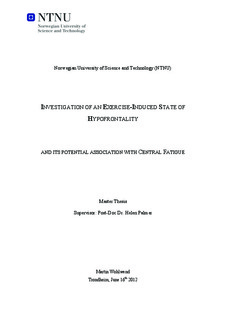| dc.contributor.author | Wohlwend, Martin | nb_NO |
| dc.date.accessioned | 2014-12-19T14:21:41Z | |
| dc.date.available | 2014-12-19T14:21:41Z | |
| dc.date.created | 2012-06-22 | nb_NO |
| dc.date.issued | 2012 | nb_NO |
| dc.identifier | 543529 | nb_NO |
| dc.identifier.uri | http://hdl.handle.net/11250/264157 | |
| dc.description.abstract | The reticular-activating hypofrontality model of acute exercise (RAH) predicts exercise-induced hypoactivity in frontal cortex which mediates executive function. Connors Continuous Performance Test (CCPT) was used to investigate changes in executive function during- and post treadmill running in healthy volunteers (n=30, 15 male). In a randomized order, subjects performed the CCPT at rest, during low- (LI; 63% maximal heart rate; MHR) and moderate intensity (MI; 75% MHR). Separately, subjects then performed isocalorifically matched exercise bouts of LI, MI and high intensity interval training (HIT) consisting of 4x4 min with 90% MHR and 3 min recovery at 60-70% MHR. Repeated measures ANOVAs revealed main effects of exercise intensity for reaction time RT during- (p≤0.001) and post exercise (p≤0.0001). Subsequent analyses showed an overall increase of RT during exercise compared to rest (p≤0.005). RT decreased significantly from rest to post exercise levels in an exercise intensity dependent, linear fashion (p≤0.0001). Commission errors showed a non significant linear trend to increase both during (p=0.057), and post exercise (p=0.052) as a function of intensity. In a follow up study, we sought to relate observed exercise effects to frontal cortex activity through the use of transcranial direct current stimulation (tDCS) (n=4) and transcranial magnetic stimulation (TMS) over the dorsolateral prefrontal cortex (DLPFC). Prior to TMS stimulation cortical excitability was estimated post running through motor-evoked potentials (MEP) elicited from the primary motor cortex (M1) induced by single burst TMS and measured in the first dorsal interosseous (FDI) muscle using electromyography. At rest, inhibitory cathodal tDCS with left DLPFC cathode and right supraorbital anode led to improved reaction time and increased amount of commission errors, whereas anodal stimulatory tDCS in the immediate post exercise period was unable to recover the post exercise effect. Continuous theta burst stimulation over the left DLPFC post running further impaired inhibitory control and facilitated reaction time. Different findings during- and after- exercise suggests that potential contributing mechanisms such as computational and metabolic factors may be differentially active during these respective conditions. Furthermore, the fact that an inhibitory TMS protocol pronounced the post running effects even more and that we were able to mimic the reported RAH effects at rest with inhibitory frontal tDCS, but observed different patterns during exercise, suggests that the latter state cannot be fully explained by reducing activity in the left frontal cortex alone. Failure to modify the after exercise effect with stimulatory tDCS also supports an interplay of different factors and might emphasize the strong, robust effects of exercise that cannot simply be attenuated by current application. Increases in MEP post running for 35min paired with the observed performance decrements imply an excited state of M1 and might serve as an explanatory cross-link to central fatigue suggesting that a hypofrontal state might enhance the motor cortical drive to activate muscles. | nb_NO |
| dc.language | eng | nb_NO |
| dc.publisher | Norges teknisk-naturvitenskapelige universitet, Det medisinske fakultet, Institutt for nevromedisin | nb_NO |
| dc.subject | hypofrontality | en_GB |
| dc.subject | TMS | en_GB |
| dc.subject | tDCS | en_GB |
| dc.subject | Conners Continuous Performance Test | en_GB |
| dc.subject | Exercise | en_GB |
| dc.subject | RAH | en_GB |
| dc.subject | motor-evoked potential | en_GB |
| dc.subject | central fatigue | en_GB |
| dc.subject | dorsolateral prefrontal cortex | en_GB |
| dc.subject | primary motor cortex | en_GB |
| dc.subject | Medicine | en_GB |
| dc.title | Investigation of an Exercise-Induced State of Hypofrontality: And its Potential Association with Central Fatigue | nb_NO |
| dc.type | Master thesis | nb_NO |
| dc.source.pagenumber | 101 | nb_NO |
| dc.contributor.department | Norges teknisk-naturvitenskapelige universitet, Det medisinske fakultet, Institutt for nevromedisin | nb_NO |
